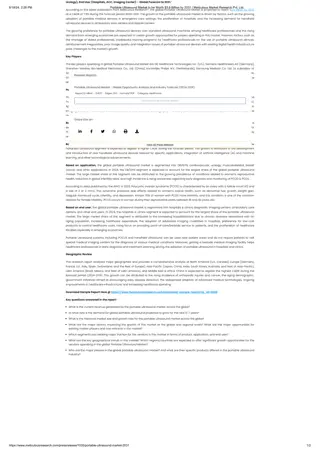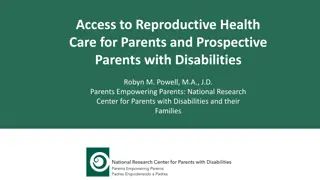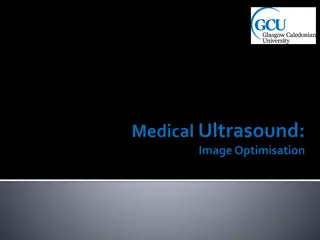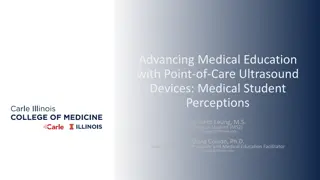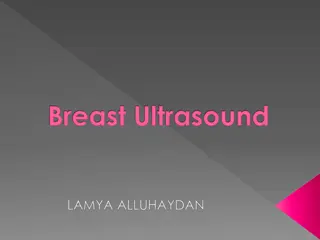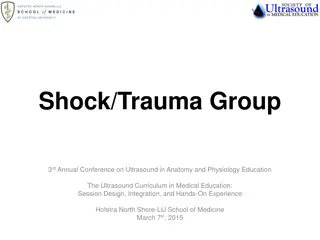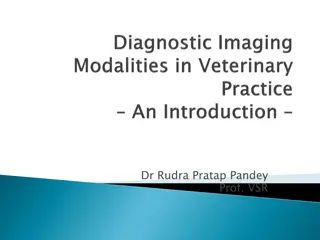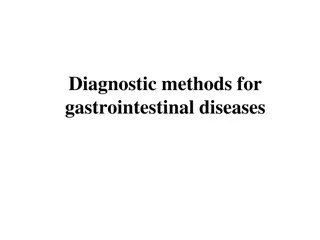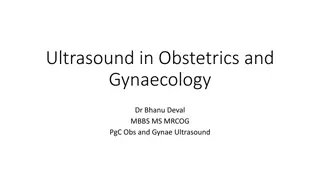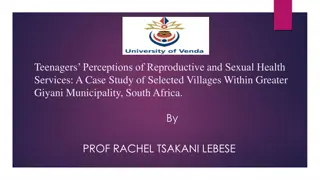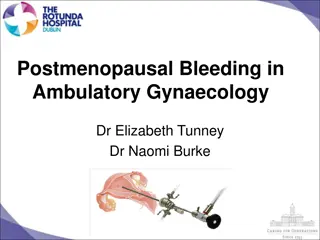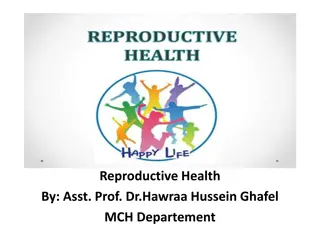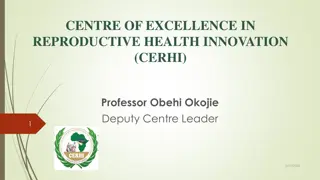
Ultrasound Technology and Reproductive Health Study
"This study delves into the intersections of medical technology, particularly ultrasound, with feelings and health, focusing on pregnancy. It involves interviews with various populations to explore these dynamics in depth, considering the risks and ethical implications involved in the research."
Download Presentation

Please find below an Image/Link to download the presentation.
The content on the website is provided AS IS for your information and personal use only. It may not be sold, licensed, or shared on other websites without obtaining consent from the author. If you encounter any issues during the download, it is possible that the publisher has removed the file from their server.
You are allowed to download the files provided on this website for personal or commercial use, subject to the condition that they are used lawfully. All files are the property of their respective owners.
The content on the website is provided AS IS for your information and personal use only. It may not be sold, licensed, or shared on other websites without obtaining consent from the author.
E N D
Presentation Transcript
Board Considerations Dec 13, 2024 UP-24-01132
Study Summary -Overview This study involves audio-recorded interviews with 4 different populations to learn about the relationship between medical technology (especially ultrasound), feelings, and health, including pregnancy.
Study Summary 4 Participant Populations The PI as designated the 4 participant populations as: Participant group 1: Individuals with knowledge of the development and commercialization of ultrasound technology. Participant group 2: Individuals with knowledge of either the entertainment and/or legislative and/or legal dimensions of this technology s commercialization and provision. Participant group 3: Individuals with professional knowledge and/or experience in medical imaging technology/ultrasound technology provision; for example, health clinics, medical providers, sonographers, doctors, and/or nurses who provide this service. Participant group 4: Individuals who have undergone, or are undergoing, medical imaging/ultrasound procedures in the context of sexual and/or reproductive health and/or obstetrics. The PI has stated that participants in categories 1 and 2 are at lower risk of harm than participants in categories 3 and 4.
Reproductive decision-making, infertility, pregnancy, and pregnancy loss (including abortion and miscarriage) intersect with ultrasound technology and its sexual health/obstetric applications. The sociopolitical and legal context related to ultrasound provision, may have expanded possibilities for the surveillance and potential criminalization of pregnancy. Access to abortion-related procedures may change depending on states Project 2025 concerns Want to ensure topics like "gender," "abortion," "reproductive health," and "reproductive rights" in the context of the ultrasound - doesn t increase risk to participants. Is a CoC needed? Study Summary Risk Context
The board make determinations about these topics 1. Determination of Risk 2. Applicable Waivers Waiver of Documentation of Informed Consent Waiver of Informed Consent 3. Vulnerable Populations 4. Criteria for Approval
1. Risk Determination First, the board is asked to consider whether this study constitutes Greater Than Minimal Risk. Per 45 CFR 46.102: Minimal Risk is defined as the probability and magnitude of harm or discomfort anticipated in the research are not greater in and of themselves than those ordinarily encountered in daily life or during the performance of routine physical or psychological examinations or tests. While the board must assess the risk for the overall study, we will break down the risk by population
Participant group 1): Individuals with knowledge of the development and commercialization of ultrasound technology. Participant group 2: Individuals with knowledge of either the entertainment and/or legislative and/or legal dimensions of this technology s commercialization and provision Participant group 3): Individuals with professional knowledge and/or experience in medical imaging technology/ultrasound technology provision; for example, health clinics, medical providers, sonographers, doctors, and/or nurses who provide this service. Participant group 4: Individuals who have undergone, or are undergoing, medical imaging/ultrasound procedures in the context of sexual and/or reproductive health and/or obstetrics. If the board determines any category of participants is at Greater Than Minimal Risk, the study will be classified as GTMR. Question for the Board: For each category of participants, is the risk minimal or GTMR?
2. Applicable Waivers : Waiver of Documentation of Informed Consent Determine if Waiver of Documentation of Informed Consentis applicable for this study. This might more colloquially be referred to as a Waiver of Signed Consent (aka no signatures of participants)
Consider the Protocol Should a waiver of documentation of IC be granted based on sensitive topics including reproductive decision- making, infertility, pregnancy, and pregnancy loss (including abortion and miscarriage) intersect with ultrasound technology and its sexual health/obstetric applications. Yes/No? In anticipation of this changing context and the unpredictable implications of such change for respondents, Given the ongoing changes in the sociopolitical and legal climate, could present future risks to participants who discuss personal or professional experiences with pregnancy termination (including but not limited to miscarriage, embryo creation and destruction, and abortion procedures). Yes/No? Yes/No?
Per 45 CFR 46.117(c)(1): An IRB may waive the requirement for the investigator to obtain a signed informed consent form for some or all subjects if it finds any of the following: Question for the Board: Is a Waiver of Documentation of Informed Consent Applicable? i.That the only record linking the subject and the research would be the informed consent form and the principal risk would be potential harm resulting from a breach of confidentiality. Each subject (or legally authorized representative) will be asked whether the subject wants documentation linking the subject with the research, and the subject s wishes will govern; or ii.That the research presents no more than minimal risk of harm to subjects and involves no procedures for which written consent is normally required outside of the research context; or iii. If the subjects or legally authorized representatives are members of a distinct cultural group or community in which signing forms is not the norm, that the research presents no more than minimal risk of harm to subjects and provided there is an appropriate alternative mechanism for documenting that informed consent was obtained.
Consider the Protocol Should a waiver of documentation of IC be granted based on sensitive topics including reproductive decision- making, infertility, pregnancy, and pregnancy loss (including abortion and miscarriage) intersect with ultrasound technology and its sexual health/obstetric applications. Yes/No? In anticipation of this changing context and the unpredictable implications of such change for respondents, Given the ongoing changes in the sociopolitical and legal climate, could present future risks to participants who discuss personal or professional experiences with pregnancy termination (including but not limited to miscarriage, embryo creation and destruction, and abortion procedures). Yes/No? Yes/No?
2. Applicable Waivers Waiver of Informed Consent The PI has requested to use an information sheet (which does not contain all consent elements) in lieu of a full consent process for participants that she considers to be at lower risk of harm(those in Participant group 1or 2). Use of an information sheet could be used if the consent is waived. Participant group 1: Individuals with knowledge of the development and commercialization of ultrasound technology. Participant group 2: Individuals with knowledge of either the entertainment and/or legislative and/or legal dimensions of this technology s commercialization and provision. Participant group 3: Individuals with professional knowledge and/or experience in medical imaging technology/ultrasound technology provision; for example, health clinics, medical providers, sonographers, doctors, and/or nurses who provide this service. Participant group 4: Individuals who have undergone, or are undergoing, medical imaging/ultrasound procedures in the context of sexual and/or reproductive health and/or obstetrics.
Per 45 CFR 46.116(f)(3): In order for an IRB to waive or alter consent as described in this subsection, the IRB must find and document that: Question for the Board: Is a Waiver of Consent Applicable? i. The research involves no more than minimal risk to the subjects; ii. The research could not practicably be carried out without the requested waiver or alteration; iii. If the research involves using identifiable private information or identifiable biospecimens, the research could not practicably be carried out without using such information or biospecimens in an identifiable format; iv. The waiver or alteration will not adversely affect the rights and welfare of the subjects; and v. Whenever appropriate, the subjects or legally authorized representatives will be provided with additional pertinent information after participation.
If the board finds that the Waiver of Consent is applicable, the board must designate which populations it applies to. Question for the Board: For Which Populations is the Waiver of Consent Applicable? Participant group 1: Individuals with knowledge of the development and commercialization of ultrasound technology. Participant group 2: Individuals with knowledge of either the entertainment and/or legislative and/or legal dimensions of this technology s commercialization and provision. Participant group 3: Individuals with professional knowledge and/or experience in medical imaging technology/ultrasound technology provision; for example, health clinics, medical providers, sonographers, doctors, and/or nurses who provide this service. Participant group 4: Individuals who have undergone, or are undergoing, medical imaging/ultrasound procedures in the context of sexual and/or reproductive health and/or obstetrics.
3. Vulnerable Populations Subpart B Next, the board is asked to consider whether a Subpart Bis applicable for this study. Subpart B ( 46.204 -Research involving pregnant women or fetuses) is intended to offer additional protections for pregnant persons or fetuses; however, it was created with biomedical risks in mind (research risks that could pose physical / developmental risk to the fetus).
Consider instead the political climate
Continuing Review Should Continuing Review be required? The board to determine the frequency of continuing review, if required.
4. Criteria for Approval (The 111 Criteria ) Finally, the board is asked to consider whether the 111 Criteria have been met. Per 46.111 --Criteria for IRB approval of research, in order to approve a research study, the board must determine that all 111 Criteria have been satisfied. We will walk through each of the criteria for purposes of determining if the current study is approvable.
(1) Risks to subjects are minimized: Question for the Board: Is this 111 Criterium Satisfied? (i) By using procedures that are consistent with sound research design and that do not unnecessarily expose subjects to risk, and (ii) Whenever appropriate, by using procedures already being performed on the subjects for diagnostic or treatment purposes.
(2) Risks to subjects are reasonable in relation to anticipated benefits, if any, to subjects, and the importance of the knowledge that may reasonably be expected to result. Question for the Board: Is this 111 Criterium Satisfied? In evaluating risks and benefits, the IRB should consider only those risks and benefits that may result from the research (as distinguished from risks and benefits of therapies subjects would receive even if not participating in the research). The IRB should not consider possible long-range effects of applying knowledge gained in the research (e.g., the possible effects of the research on public policy) as among those research risks that fall within the purview of its responsibility.
(3) Selection of subjects is equitable. Question for the Board: Is this 111 Criterium Satisfied? In making this assessment the IRB should take into account the purposes of the research and the setting in which the research will be conducted. The IRB should be particularly cognizant of the special problems of research that involves a category of subjects who are vulnerable to coercion or undue influence, such as children, prisoners, individuals with impaired decision- making capacity, or economically or educationally disadvantaged persons.
Question for the Board: Is this 111 Criterium Satisfied? (4) Informed consent will be sought from each prospective subject or the subject s legally authorized representative, in accordance with, and to the extent required by, 46.116
Question for the Board: Is this 111 Criterium Satisfied? (5) Informed consent will be appropriately documented or appropriately waived in accordance with 46.117.
Question for the Board: Is this 111 Criterium Satisfied? (6) When appropriate, the research plan makes adequate provision for monitoring the data collected to ensure the safety of subjects.
(7) When appropriate, there are adequate provisions to protect the privacy of subjects and to maintain the confidentiality of data. Question for the Board: Is this 111 Criterium Satisfied? Note: The PI plans to request a Certificate of Confidentiality from the NIH. The board can also require a CoC.
(b) When some or all of the subjects are likely to be vulnerable to coercion or undue influence, such as children, prisoners, individuals with impaired decision-making capacity, or economically or educationally disadvantaged persons, additional safeguards have been included in the study to protect the rights and welfare of these subjects. Question for the Board: Is this 111 Criterium Satisfied?


